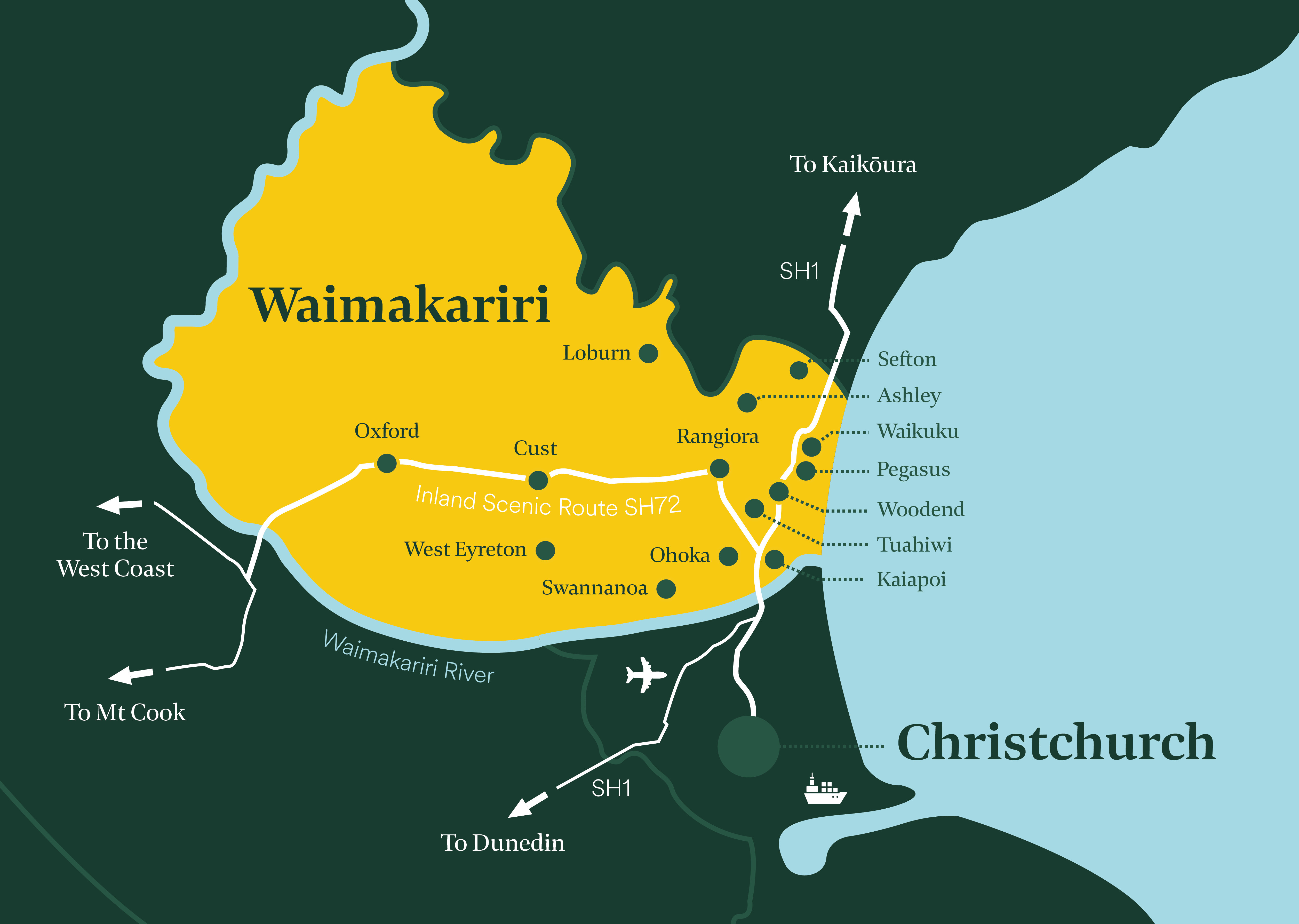Waimakariri is a fast-growing area, with a population of 69,000 (Subnational Population Estimates to June 2024) in 25,401 households (Census 2023). Waimakariri is just north of Christchurch, the largest city in the South Island of New Zealand and easy commuting distance. Waimakariri has seen a 13% increase in population since the census in 2018 and 45% GDP growth over the same period (-0.9% GDP growth over the year to March 2024). Mid level projections estimate that Waimakariri will have a population of 77,100 by 2033.
Within Waimakariri, the most rapid growth area is in Rangiora with many new options now ready for purchase or lease but there are still many opportunities in the Woodend/Pegasus area and a large number of sections and commercial areas available. 65% of the Waimakariri population is within the urban areas.
In 2023 the median age in Waimakariri District was 44.7 years. The district’s population is ageing, with the median age having increased from 43.6 at the 2018 census, and from 42.9 in 2013.
Data Sources: Aotearoa Data Explorer
Waimakariri is a comparatively affordable place to live with the February mean house value at $713,753 compared to $764,550 in Christchurch, $912,299 for New Zealand or $839,113 for the Selwyn District.
67.4% of households in Waimakariri District own their own home. This is slightly above the average rate for New Zealand, at 64.5%
House prices continue to rise in Waimakariri. House prices to February 2025 in Waimakariri rose 1.7%, Christchurch rose by 3.4% and Selwyn rose by 2.6%. New Zealand house prices overall increased by 0.9%.
The average (mean) weekly rent for the Waimakariri District in March 2025 was $562, slightly under the national average of $575. Rent levels in Waimakariri rose 5.1% over the last year.
Sizable new housing areas have been established in Rangiora, Kaiapoi and Woodend to keep up with demand.
Mean incomes for households in Canterbury were $132,300 in 2024 which was lower than New Zealand overall ($140,900) and a rise of 8.4% compared to the previous year.
Data sources: MBIE
There were 7,305 businesses in the Waimakariri District in 2024, an increase of 1.0% on the previous year. These businesses employed 18,300 people (An increase of 1.7%). Approximately 72% of those businesses have no employees and 5.7% of businesses have 10 or more staff. 66.5% of the working population choose to work within the district.
Data Sources: Aotearoa Data Explorer, Waimakariri Business Development Report
The following chart shows the consumer market for the following industries in Waimakariri. The grey bars show where residents spend their money locally, the blue bars on the left show where residents spend their money out of district (usually Christchurch) and the blue bars show where non-locals spend their money within the district.
Net Position: Direct Consumer Market
Consumer spend has remained steady in Waimakariri with an annual increase to March 2025 of 0.2% compared to -1.4% nationally. The total consumer spend in the district is $814m.
Tourism is a very small part of the Waimakariri landscape, but has great potential for investment. In the year to April 2025 the electronic spend for domestic tourism in Waimakariri District grew 4.1% to $44.4m. Electronic spend for international tourism grew 28.3% to $11.8m.
Christchurch NZ provides a report looking at the wider tourism picture for Canterbury.
Visit Waimakariri is the visitor attraction agency for the district
Data Sources: MBIE Reliance on Tourism webtool
While the unemployment rate in the Waimakariri District is traditionally at low levels (3.6% in March 2025 compared to 4.9% for New Zealand) it is usually relatively easy to find low and mid skilled workers. That is because 32% of Waimakariri workers commute to Christchurch for work. In the most recent Waimakariri Community Survey, 72% of these workers stated in that they would prefer to work in the Waimakariri if suitable work were available.
Internet advertising and word of mouth tend to be the most effective ways to promote jobs in this district.
Finding highly skilled workers is traditionally more difficult in Waimakariri due to a smaller pool of talent (due to population numbers) than in cities, and due to the fact that local workers are generally not actively looking for local positions. Highly skilled Christchurch residents are generally happy to take the short commute to a good job in Waimakariri.
The Jobs in North Canterbury website run by ENC is a popular resource for employers looking for local workers listing the local agencies and assistance that can help you source workers
The North Canterbury – Move On Up Website provides a wealth of resource to help attract workers by demonstrating the attractive lifestyle in North Canterbury
Data Sources: Infometrics, Waimakariri Community Survey, North Canterbury Business Opinion Survey
The Waimakariri District of North Canterbury covers some 225,000 hectares, bordered by the Waimakariri River in the south, the Puketearaki Range in the west, Pegasus Bay in the east and the Hurunui District boundary to the north.
The major urban towns of the Waimakariri District are Rangiora and Kaiapoi, with Oxford, Woodend and Pegasus adding to the district’s population and services.

This page is a brief overview of the business demographics and data for the Waimakariri District. Thank you to the Waimakariri District Council who provided the majority of charts and graphs shown on this page.
Last updated in June 2025. If you require more in depth or recent information please contact our Business Support Manager, Miles Dalton.